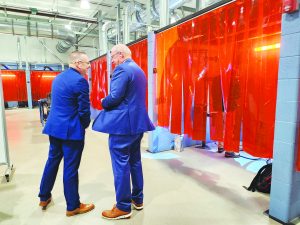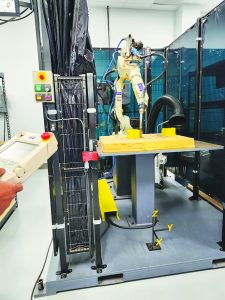Ninth District U.S. Rep. Morgan Griffith toured the MET Complex at Patrick & Henry Community College (P&HCC) on September 3, guided by college President Dr. Greg Hodges. The visit focused on the college’s welding programs and industrial courses.

During the tour, Rhonda Hodges, vice president of Workforce, Community, and Economic Development, provided Griffith with historical context about the complex. “These two buildings previously housed Arrington Engines, where Dodge Hemi engines for NASCAR were produced,” Rhonda Hodges explained.
Greg Hodges detailed the funding and development of the complex, noting that federal and Harvest Foundation grants, along with $22 million in raised funds, were used to revitalize the facility. “We initially had 16 welding booths, which were in high demand with a 60 to 70 person waiting list,” Greg Hodges said. “Now, we have 45 welding booths and have significantly expanded our capacity and dual enrollment options.”
Griffith, R-Salem, inquired about local job opportunities for welders, acknowledging that welding is an underserved field. “Welding is an area with high demand, but jobs can require relocation,” he said.
Greg Hodges clarified that while students often receive job offers before completing their programs, the challenge is ensuring they finish their degrees. “Students receive AWS American Society of Welding certifications during their training, which can lead to numerous job offers,” he said. The college has addressed this by incorporating frontloaded courses to encourage program completion.

The tour also included P&HCC’s robotic welding facilities. Griffith asked about the local impact of robotic welding and the availability of programs for robot maintenance.
Colin Ferguson, Dean of STEM-HAP, confirmed an increase in requests for robotic welding and highlighted the college’s Mechatronics program, which partnered with Festo in 2023 to award the most certifications in the U.S.
Greg Hodges emphasized the importance of students mastering manual welding skills before programming robots. “We insist that students learn the skill themselves before they program the robot,” he said.
Griffith agreed, noting that understanding the skill helps ensure robots are operating correctly.
P&HCC offers virtual welding as an introductory tool, which provides a safer learning environment. “Virtual welding allows students to practice without the risks of real welding,” Ferguson said. Griffith acknowledged the cost of equipment but noted its long-term cost-saving benefits.
The tour also featured the workforce flex space and the mechatronics lab, designed for customizable workforce training. “Economic development pitches often highlight our campus,” Greg Hodges noted. Griffith expressed surprise at the scope of P&HCC’s programs, emphasizing the national need for trained mechatronics professionals.
P&HCC’s programs offer both long- and short-term certifications that can transfer with students, providing flexibility in their career paths. “We are about to launch Level 3 of our program at Patrick & Henry, thanks to our faculty’s efforts,” Rhonda Hodges said.
Griffith underscored the value of vocational education. “You can achieve a good-paying career without the burden of a four-year college degree,” he said, noting that industrial jobs require a different type of intelligence.
Greg Hodges added that many students benefit from programs that are financially accessible.




